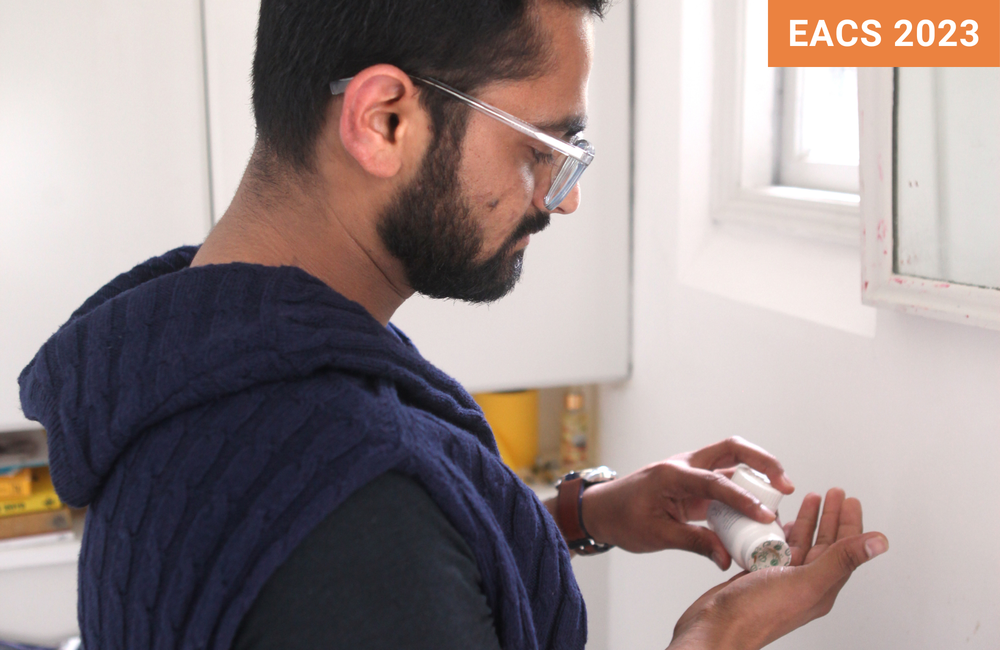
A randomised controlled trial exploring the plausibility of dosing two-drug antiretroviral therapy four days a week rather than daily found that viral suppression rates on both dosing schedules were similar, but the rate of virological failure and resistance were concerningly higher in the four days a week group. Results were presented in a poster at the 19th European AIDS Conference (EACS 2023) in Warsaw this week.
The authors have previously had promising results with five and four consecutive days a week of triple-drug therapies. They believe that this ‘intermittent dosing’ may reduce side effects, costs and be more convenient for people with HIV. However, the long-term sustainability and risk of developing resistance on intermittent dosing continues to receive criticism from some HIV experts. Despite similar rates of viral suppression in their QUATUOR study, in the long run intermittent dosing on triple therapy seems to lead to a slightly higher risk of treatment failure and the risk-to-benefit assessment is still under question.
Intermittent dosing has never previously been tried with dual therapy. Like intermittent dosing, dual therapy (using two rather than three antiretrovirals) is a relatively new concept in HIV treatment and despite having proved equally effective, is still approached with pessimism by some HIV experts. In other words, combining the two concepts is rather a daring idea.
The study
Between June 2021 and January 2022, 433 people with HIV were enrolled and completed the study at several HIV treatment centres in France. They needed to have been continuously undetectable for more than a year and have no resistance to the drugs in their dual regimen. Then they were randomly assigned to two groups; 219 people in the intermittent-dosing group (four consecutive days per week) and 214 in the daily-dosing group. The intermittent regimen had to sustain a similar rate of virological failure compared to daily dosing at one year in order to be non-inferior (equally effective).
Among the participants, 66% were on dolutegravir plus lamivudine (known as Dovato), 34% were on dolutegravir plus rilpivirine (known as Juluca) and only three on darunavir plus lamivudine. The remaining characteristics such as age, time since diagnosis and time with undetectable viral load were similar between both groups.
Similar rates of viral suppression
At one year, the difference in the rates of viral suppression between both dosing schedules was negligible. Of those following intermittent dosing, 94.5% remained undetectable compared to 96.3% of the participants who took their medication daily.
Higher rates of treatment failure on intermittent dosing
There were eight cases of treatment failure in the intermittent-dosing group as opposed to none in the daily-dosing group. At this point, the study could not reach ‘non-inferiority’; in other words, it failed to prove that intermittent dosing was as efficacious as daily dosing on dual therapy.
Six of the eight treatment failures on intermittent dosing occurred in those who took dolutegravir plus lamivudine. This is not surprising given lamivudine’s short half-life (the time it stays in the body) and relatively low barrier to resistance (meaning the virus can quickly develop resistance to it when the concentration is low) compared to rilpivirine.
Interestingly, when measured, most of the participants with treatment failure had adequate amounts of drug in their blood; however, this does not exclude the possibility of them having had transient periods of insufficiently low drug concentrations before the treatment failure occurred.
The time treatment failure occurred varied from four weeks to 36 weeks. In most, despite being detectable, the viral load remained below 200 copies (in other words – untransmissible). However, in two participants the viral load reached values around 1000 copies.
Resistance on intermittent dosing
Among the eight participants who experienced treatment failure on intermittent dosing, four were found to have resistance to their current treatment. Two of them had a virus that already had some resistance to the treatment drugs before the study. One of the four cases of resistance had low drug levels in their blood which probably led to the development of resistance. Seven of the participants with treatment failure were switched back to daily dosing and one to long-acting cabotegravir plus rilpivirine (Vocabria and Rekambys) and reached undetectable status.
Takeaway
The studies that have so far explored intermittent dosing have proved the potency of contemporary triple-drug HIV treatment and have arguably had promising results; intermittent dosing on dual therapy seems to go beyond the limits of what is possible and plausible. Dual therapy is already a way of reducing drug burden; in this context further reduction in drug exposure with a higher risk of treatment failure is hardly justifiable. The study also suggests that dual therapies, at least some of them, might be less forgiving of skipped and missed doses.
Landman R et al. ANRS 177 DUETTO randomized, open-label and multicentric trial evaluating the non-inferiority of maintenance antiretroviral dual therapy taken 4 consecutive days per week versus dual therapy 7/7 days per week. 19th European AIDS Conference, Warsaw, poster eP.A.106, 2023.
